We need to change the way we think of lawns. Envision your turf as an area rug instead of wall-to-wall carpet. By doing so, turf becomes an area with a purpose rather than a huge expanse that is rarely used and might even be difficult to mow.
In last month’s Gardening Journey, I discussed the history of lawns and our contemporary obsession with surrounding our homes with flawlessly green and perfectly mowed turf. While many homeowners associate a green lawn with sumptuousness, in reality it is the most sterile part of a garden. I suggested that it is time to reduce the area of turf around our homes because the required mowing, trimming, fertilizing and watering equates to an ecological disaster.
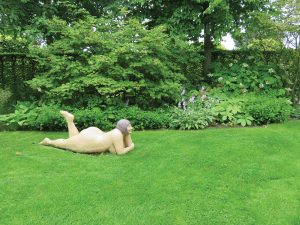 Reducing the area of turf may seem like a daunting task, but the changes can be made gradually over several years and as time and resources allow. The easiest solution is to simply shrink the lawn to areas that serve a specific function: for children to play, for lounging, a welcome mat for visitors, for the dog’s needs, or just a restful spot for the eye. The lawn can be carved to become circular, rectangular, irregular or whatever shape, and then framed by beds. By replacing corners with curves and having islands of grass, even a small reduction on lawn size can save a lot of work. If you must water regularly, why not target an area that is farthest from the house, or the part of your lawn that is least-used because it is shaded, steeply sloped or full of tree roots as the first step of your project.
Reducing the area of turf may seem like a daunting task, but the changes can be made gradually over several years and as time and resources allow. The easiest solution is to simply shrink the lawn to areas that serve a specific function: for children to play, for lounging, a welcome mat for visitors, for the dog’s needs, or just a restful spot for the eye. The lawn can be carved to become circular, rectangular, irregular or whatever shape, and then framed by beds. By replacing corners with curves and having islands of grass, even a small reduction on lawn size can save a lot of work. If you must water regularly, why not target an area that is farthest from the house, or the part of your lawn that is least-used because it is shaded, steeply sloped or full of tree roots as the first step of your project.
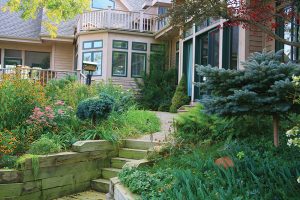 Another approach is to construct a patio near the front or back entrance, which moves the lawn further from the house. I also recommend that you simply enlarge your garden borders. Let the lawn be a spot in the midst of a lush garden. Adding shrubs around the perimeter of the yard will also reduce the size of your lawn and add a sense of privacy.
Another approach is to construct a patio near the front or back entrance, which moves the lawn further from the house. I also recommend that you simply enlarge your garden borders. Let the lawn be a spot in the midst of a lush garden. Adding shrubs around the perimeter of the yard will also reduce the size of your lawn and add a sense of privacy.
Or, consider adding some trees; I’ve recommended specific trees in several of my past columns. Depending on the size of the trees you can accommodate, a large section of turf is taken away. Take a picture of the area where you are thinking of installing a new planting, make a note of the hours of sun exposure (and particularly the drainage after a big rain), and seek advice from your nursery.
Trees, shrubs and perennials can be planted in layers, which will require less water. Plants should be closely spaced to discourage weeds. (Mulching is not the best way to discourage weeds despite the common thinking.)
Plants to Replace Turf
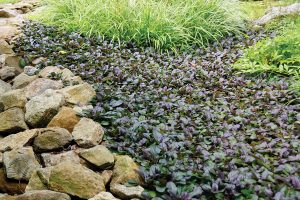 It is best to replace grass with broad areas of one or a few types of plants. Once established, lots of plants of only a few kinds will be easier to maintain and look better. Early-on weeding will be necessary until the plants spread and cover the ground.
It is best to replace grass with broad areas of one or a few types of plants. Once established, lots of plants of only a few kinds will be easier to maintain and look better. Early-on weeding will be necessary until the plants spread and cover the ground.
Those with a larger property should consider establishing a meadow. It is not as easy as “meadow in a can” ads would suggest, but once established it will be colorful and full of birds, bees and butterflies.
What follows are some suggested plants that would be appropriate:
Dutch clover (Trifolium repens)
As water and energy costs rise, clover is an ideal replacement to the traditional water-hungry, labor-intensive lawn. Clover was the standard of excellence in lawns until the 50s, when people started to use broadleaf herbicides to kill off weeds, which also killed the clover. Clover stays green year-round, withstands normal foot traffic, and is heat- and drought-tolerant. It can be mowed regularly to remove the flowers if desired. But, keep in mind that the flowers are loved by honey and native bees, which help pollinate your garden and a third of all human food crops. Oh, and clover is not damaged by dog urine.
Clover grows quickly and easily. It has a deep root system, reduces soil compaction, and takes nitrogen from the air and releases it slowly, enriching the soil. Additionally, clover is affordable and easy to grow. It needs little or no watering or mowing, chemical fertilizers are not needed, and it stays green, even in the driest part of summer. One pound of seed covers 1,000 sq. ft. The best time to plant is after the last frost in spring, when rain will help it establish. One recommendation is to mix the clover seed with sand when spreading. Some spreaders will not work with the tiny clover seeds.
Reliable clovers are Dutch White, Yellow Blossom and Red Clover. Dutch White is best suited for lawn-type use, Yellow Blossom is for pastures. Clover will grow well in poor clay subsoil common around new home construction.
A disadvantage of clover is that it stains clothing more easily than grass and is not durable for playing fields unless mixed with grass. It will naturally reseed if the flowers are not removed.
Bugleweed (Ajuga reptans cvs.)
Because of its relentless spreading from edges, turf-loving gardeners are not fond of bugleweed (to put it mildly). But, it is a favorite “desperation plant” of mine. It will grow in full sun to part shade and is covered with showy blue flowers in late spring (spent flower spikes can be mowed on a high mower setting). It is great for covering difficult slopes, to fill in under woody plants or to cover stony areas, and it will thrive under walnut trees. It suppresses weeds better than anything I can think of. In fact, the foliage will choke out weeds. It is not touched by rabbits or deer. Ajuga will fill in large shady areas where lawns are difficult to establish. It can be planted over spring bulbs like snowdrops. I like the burgundy-colored selections.
Creeping Lilyturf (Liriope spicata)
This is not the type of clumping lilyturf you are familiar with – L.spicata is a tough grass-like plant that spreads rapidly by underground runners to form a tight weed-resistant mat. The pale-lavender flowers appear among the 10-inch foliage later in summer. It is a good choice for under trees since it competes handily with tree roots. It is heat-tolerant and not attractive to rabbits or deer. The old foliage can be mowed in early spring. It’s ideal for stabilizing soil on banks or slopes, even along streams or ponds.
Common Periwinkle (Vinca minor)
This popular ground cover is easily grown in humusy, well-drained soil in sun or almost full shade. The trailing stems of evergreen leaves root at the nodes as they go along the ground. Blue flowers that look like phlox appear in spring and intermittently throughout summer into fall.
Creeping Thyme (Thymus cvs.)
Thyme forms a dense mat that will tolerate moderate foot traffic. The fragrant foliage is often green all winter; some cultivars turn bronze. Thyme requires full sun and good drainage to thrive but is deer-resistant and hardy. The spring flower colors, which vary with cultivars, attract pollinating insects. And, the cooks in the family will be pleased to be able to pick sprigs for seasonings.
Mazus (Mazus reptans)
This very low-growing and underused plant has showy purplish-blue flowers in early summer and is great for filling in cracks between stepping stones. Easy to grow, mazus spreads by creeping stems that root at the nodes as they go. The dense foliage tolerates foot traffic.
Chamomile (Chamaemelum nobile)
Chamomile is easily naturalized in a well-drained sunny or part-shade area. The foliage releases an apple fragrance. It can be mowed to remove spent flowers that appear from June to September. It withstands normal foot traffic after established. It can be aggressive.
Creeping Speedwell (Veronica repens cvs.)
Ground-hugging and mat-forming, speedwell is useful in part- to full-shade. Yellow-foliaged cultivars show off the blue flowers in early summer. Provide good drainage. It will tolerate some foot traffic.
Hardy Ice Plant (Delosperma cooperi)
Bright pink flowers appear all summer on this drought-tolerant plant from South Africa. It needs good drainage and sun and will not tolerate being waterlogged in winter. It is not good for traffic areas but is great on shallow-soiled, rocky slopes.
Snow-in-Summer (Cerastium tomentosum)
Great for dry sunny areas with poor, sandy or rocky soil. White flowers cover the wooly grey foliage late spring into summer. No foot traffic. Deer do not bother it. It will spread by runners but is not aggressive. However, it will self-seed if the flowers are not removed.
Buffalo Grass (Bouteloua dactyloides)
I’ve had no experience with this native grass, which spreads by runners. It is reported to be an excellent choice for a low-maintenance lawn in that it tolerates heat, drought and moderate foot traffic. It prefers a rich soil and is not a good choice for nutrient-poor sandy soils. It should be mowed in later winter and occasionally during the growing season, but never shorter than 3 inches.
Other possibilities include: Lily-of-the-valley (Convallaria majalis), Pachysandra (Pachysandra terminalis), and Daylilies (Hemerocallis sps.)

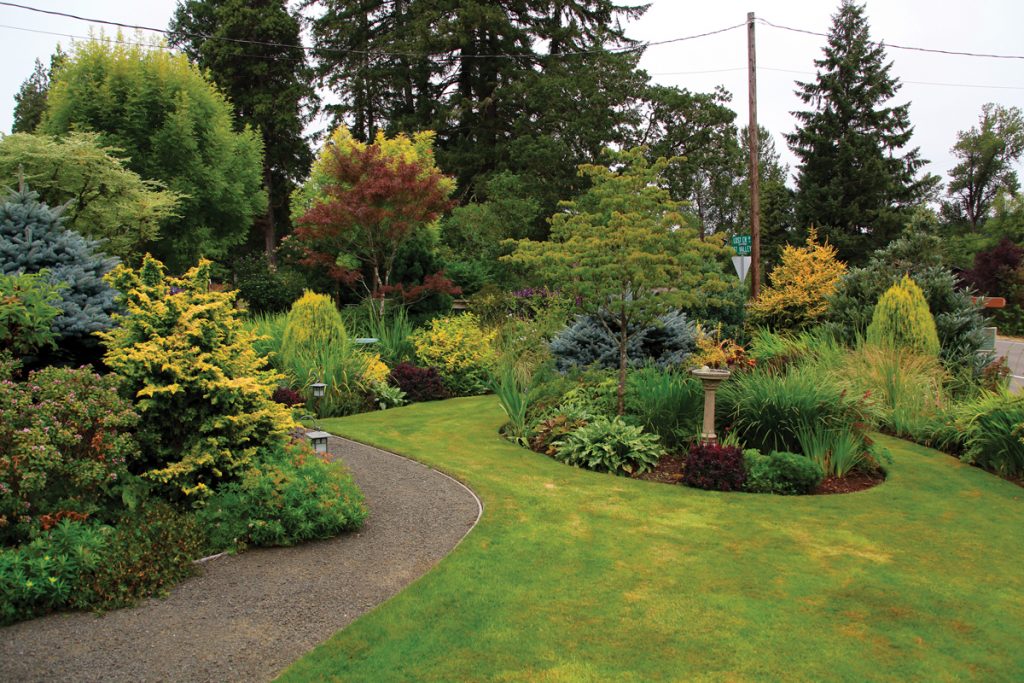
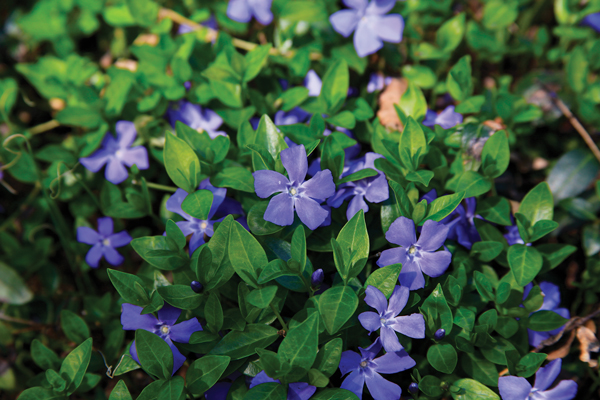
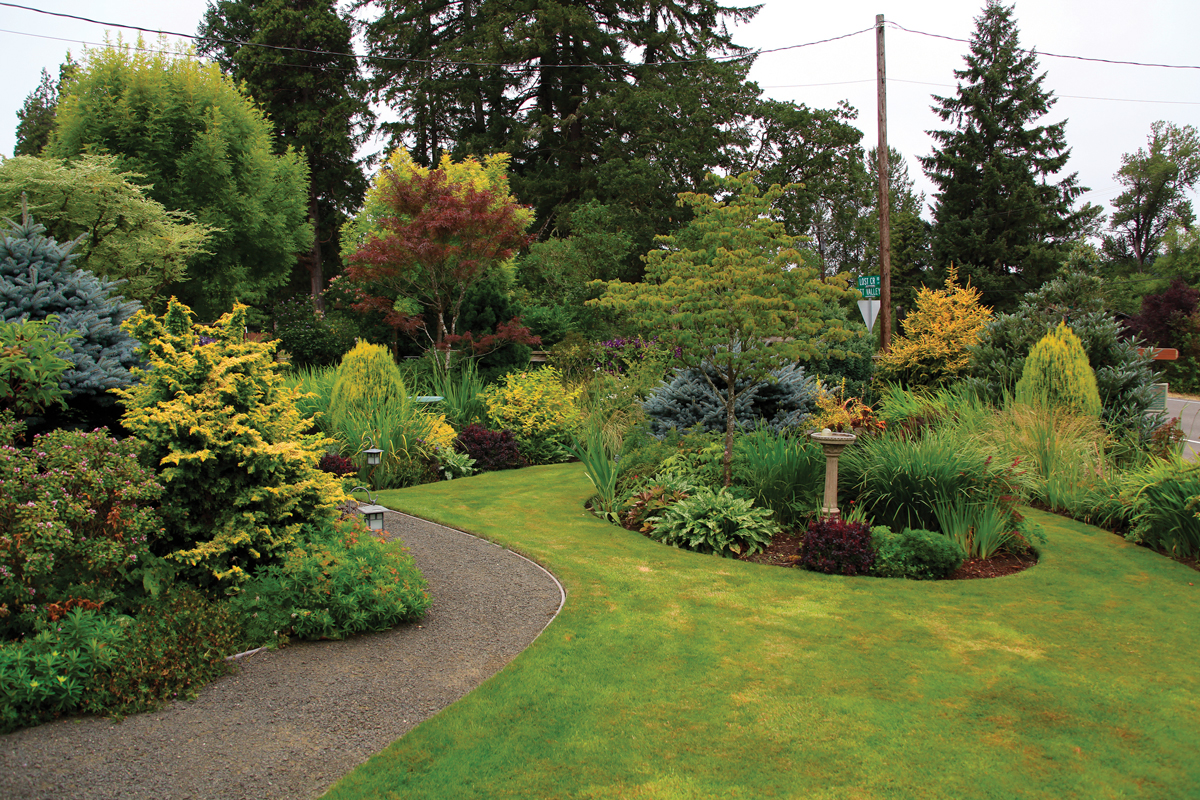
Leave a Reply